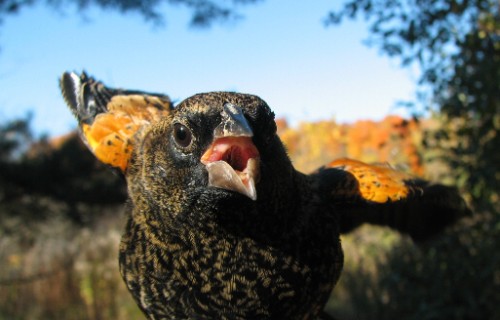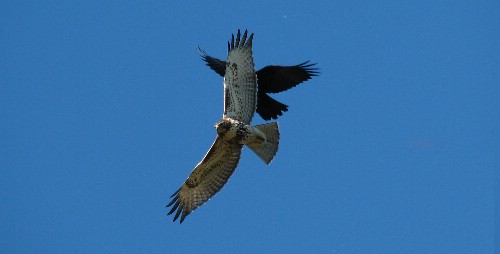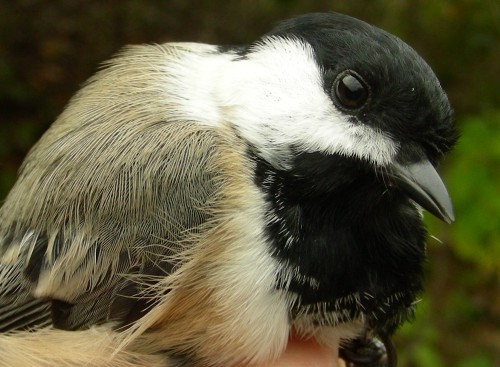|
Week 12: October 17-23, 2007 |
Welcome
to the McGill Bird Observatory weekly report.
Click here for a complete listing of our archives.
Comments or
questions are welcome at "mbo AT migrationresearch.org".
|
PICTURE
OF THE WEEK: |
|

What might be the final new species banded for the 2007 fall
season, we were lucky
enough to get two Northern Shrikes this past week: a
second-year bird (based on some
retained juvenile feathers in the wing) and a hatch year
bird. Note the differences in the
darkness of the facial mask, as well as the differences in
the colour of the face (grey vs brown).
(Photos by Marie-Anne Hudson and Greg Rand)
|
|
|
THIS WEEK |
THIS FALL |
2007 TOTAL |
SITE TOTAL |
|
# birds (and species) banded |
289 (19) |
2724 (77) |
3508 (87) |
12826 (103) |
|
# birds (and species) repeat |
43 (11) |
540 (45) |
655 (49) |
2204 (59) |
|
# birds (and species) return |
1 (1) |
45 (12) |
130 (24) |
330 (29) |
|
# species observed |
53 |
137 |
159 |
191 |
|
# net hours |
370.8 |
5060.3 |
7560 |
21582.8 |
|
# birds banded / 100 net hours |
77 |
53.7 |
46.3 |
59.4 |
|
|
Note: table does not include nocturnal banding (owls) |
Banders-in-charge: Marie-Anne
Hudson, Barbara Frei
Assistants: Jean Beaudreault, Kristen Brochu, Shawn Craik, Emilie
Dion, Melanie Drouin, Dominique Fautaux, Isaac Hebert, Tiffany Gamelin,
Gay Gruner, Marie-Melissa Kalamaras, Gillian Kinsman, Joelle Lapalme,
Alex Liautaud, Barbara MacDuff, Jennifer MacWilliam, Francine Marcoux,
Sarah Marteinson, Chris Murphy, Annie-Claude Paradis, André Pelletier,
Greg Rand, Katleen Robert, Krystal Swift, Anna Solecki, Stephanie
Steeves, Rachel Theoret-Gosselin, Rae Trenchard, Sandra Warren
Notes: Weather-wise this week contained a few days
that could have been slotted into July and no one would have been the
wiser. However, above-seasonal temperatures certainly didn’t deter our
autumn migrants! The proof is in the number of American Robins bobbing
about the site. Our highest daily total was 1150, making for some very
noisy skies. Their orangey-red breasts are the perfect colour for the
season, matching our fiery-leafed maples. The maples seem to be hanging
on to their leaves a little longer than the Eastern Cottonwoods on site,
which have lost the majority of their leaves over the past two days. No
worries, there are still have a few days to check out the fall colours
before the wind knocks them all down!
With
one week left in the fall season, we still managed to get some new
species. New species banded include two Northern Shrikes (the first
time we've banded more than one in a season, let alone a single week!)
and a Common Grackle (remarkable considering that last fall we banded 35
of them). New species observed include Pine Siskin and the
aforementioned Northern Shrike. Though we’re still over 400 birds short
of last year’s banding total at this time, we’re three species ahead in
terms of species observed, and have also banded one more species. Just
goes to show how variable seasons can be, and how much we’re at the
mercy of the weather! Another reminder of how important it is to
focus on long-term monitoring in order to separate year-to-year
fluctuations influenced by local weather patterns from actual population
trends that can be used to guide conservation strategies.
This week’s top ten banded list reflects the
week’s slowed pace relative to last week. Ruby-crowned Kinglets still
dominate despite being halved from last week. Other than the
disappearance of the Hermit Thrush and White-crowned Sparrow from the
list, enabling our little goldfinches and Golden-crowned Kinglets to pop
on, the list remains quite similar to last week’s.
|
This week’s
top 10
[last week’s rank in brackets]
|
#
individuals banded |
mean # individuals observed daily |
|
1.
Ruby-crowned Kinglet (73)
[1] |
1.
Canada Goose (946)
[1] |
|
2.
American Robin (68)
[2] |
2.
American Robin (333)
[2] |
|
3.
Slate-colored Junco (38)
[4] |
3. Red-winged
Blackbird (220)
[3] |
|
4.
Black-capped Chickadee (21)
[3] |
4.
American Crow (179)
[4] |
|
4.
White-throated Sparrow (21)
[5] |
5.
Common Grackle (108)
[9] |
|
6.
Song Sparrow (16)
[8] |
6.
European Starling (38)
[5] |
|
6.
American Tree Sparrow (16)
[8] |
7.
Slate-colored Junco (37)
[8] |
|
8.
Fox Sparrow (9)
[10] |
8.
Ruby-crowned Kinglet (20)
[6] |
|
9.
American Goldfinch (5)
[-] |
9.
White-throated Sparrow (17)
[7] |
|
9.
Golden-crowned Kinglet (5)
[-] |
10.
Black-capped Chickadee (15)
[10] |
|
The top
10 observed list for this week has simply been picked up and shaken,
causing the top and bottom to stay the same and the middle to shift
around a bit. This line-up is similar to last year’s top 10 as well,
though it lacks Cedar Waxwing (nomads that they are), Blue Jay, and
Mallard. Who knows, with the way the Mallards are beginning to appear
(54 today), they may yet end up on our top 10!
|

We were stoked to find this fine fellow in our nets this week,
since we’ve only ever gotten one per fall season before!
Granted we get our fill in spring, but in fall they tend to stay
in the tree tops far above our nets.
Interestingly, the only Red-winged Blackbird we banded in the
fall of 2006 also came in week 12! (Photo by Barbara Frei)

No, we didn’t band this Red-tailed Hawk, but we were quite
impressed at its ability to dodge our curious American Crows!
(Photo by Barbara Frei)

We were astounded to find this hatch-year Black-capped Chickadee
in our nets (twice) this week - that in itself is of course
quite common with chickadees, but this one had a massive growth
on its neck! It must be a fast-growing tumour or abscess since
it was initially banded just a week or two ago, with no signs of
any growth. It was in fine form so we released it, wished it
well, and hope to recap it again soon (minus the growth). There
is growing evidence that Black-capped Chickadees may be
vulnerable to environmental contaminants, as discussed in a
recent
article in the American Birding Association's magazine
Birding that highlights some remarkable beak deformities in
Alaska. (Photo by Marie-Anne Hudson)
|




